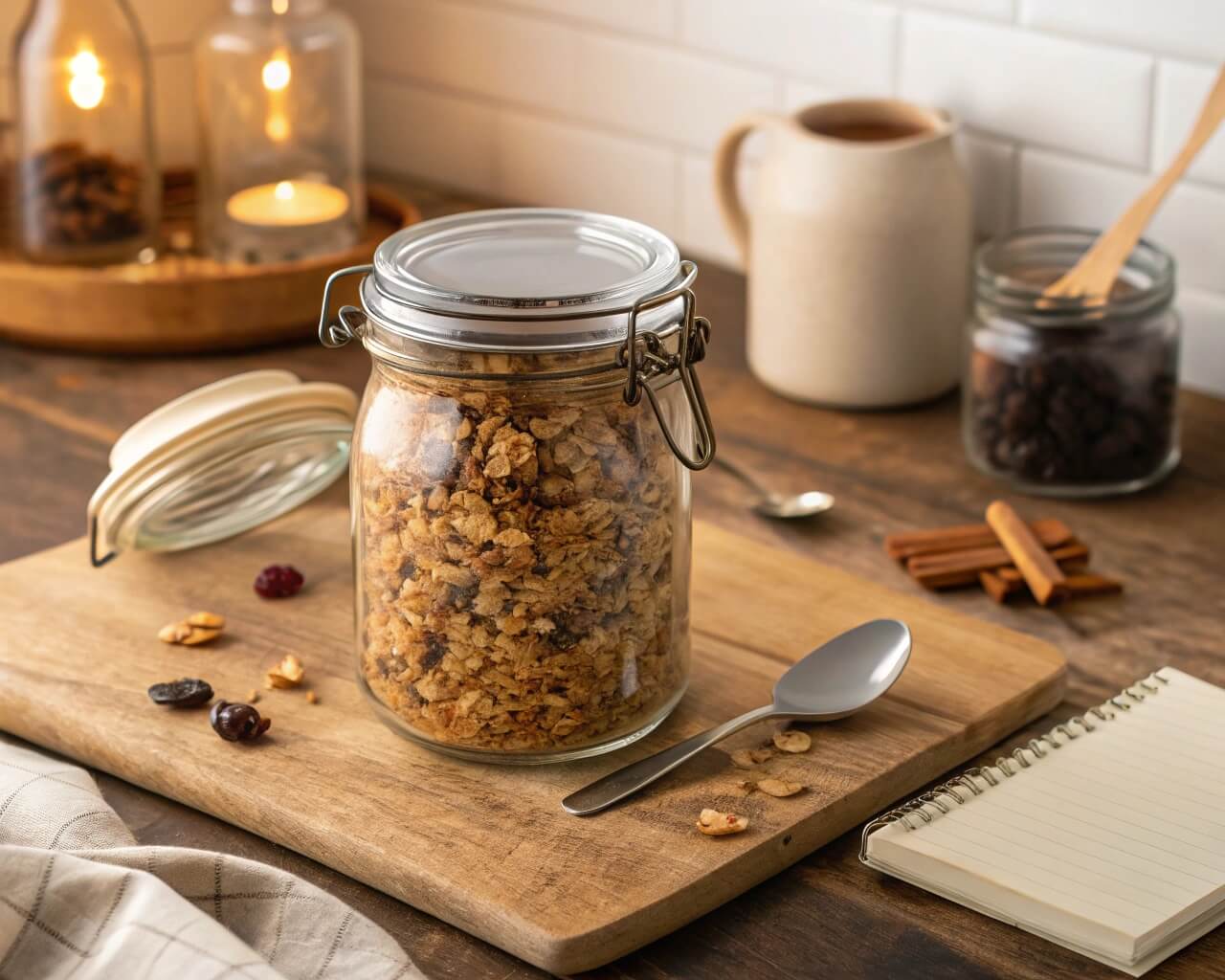Making or buying granola is great, but finding it stale or soft later is frustrating. This wastes food and spoils your enjoyment. Understanding storage keeps your granola tasting its best for longer.
Generally, homemade granola lasts about 2-4 weeks, while store-bought versions can last 6-12 months unopened. Proper storage in an airtight container in a cool, dark place is crucial for maximizing freshness for both types.

Keeping granola fresh involves more than just putting it in a container. Factors like ingredients and storage conditions play a big part. Let’s look at how long different types last and how to store them properly.
How long can granola be stored?
Are you unsure how long that batch of granola will actually stay good? Eating stale granola is disappointing, and throwing it out feels wasteful. Knowing the typical storage times helps avoid this.
Homemade granola typically stays fresh for about 2 to 4 weeks at room temperature when stored correctly. Store-bought granola often lasts much longer, sometimes 6 months or more, due to preservatives and packaging.

Factors Affecting Granola Shelf Life
Several things influence how long your granola lasts. The ingredients used are very important. Oils and nuts contain fats that can go rancid over time, especially if exposed to air and heat. Dried fruits contain moisture, which can make the granola less crisp if not stored properly. Even the type of sweetener can play a minor role. Proper cooling after baking homemade granola is also key; storing it warm traps moisture. Finally, the storage container and environment are critical. Air, light, heat, and moisture are the main enemies of freshness. Minimizing exposure to these elements is the best way to extend shelf life1.
| Ingredient/Factor | Impact on Shelf Life | Why |
|---|---|---|
| Oils & Nuts | Can shorten shelf life | Fats can oxidize and become rancid |
| Dried Fruits | Can shorten shelf life (texture) | Moisture can soften granola |
| Sweeteners | Minor impact | Sugar acts as a mild preservative |
| Cooling | Important for homemade | Prevents trapped moisture |
| Storage Container | Very important | Prevents exposure to air and moisture |
| Environment | Very important | Heat, light, moisture accelerate spoilage |
Homemade vs. Store-Bought Granola Shelf Life
Homemade granola usually has a shorter shelf life because it lacks the commercial preservatives found in many store-bought options. Its freshness window is typically weeks, not months. However, you control the ingredients, ensuring quality. Store-bought granola benefits from specialized packaging, often nitrogen-flushed, and preservatives that inhibit spoilage and staleness, allowing it to last much longer unopened. Once opened, its shelf life becomes more comparable to homemade, though potentially still longer.
Signs of Spoilage
How do you know if your granola has gone bad? Use your senses. Smell is often the first indicator; a rancid, stale, or "off" odor means it’s time to discard it. Taste follows smell – if it tastes stale or unpleasant, don’t eat it. Texture changes are also a clue; granola that should be crunchy but has become soft or chewy (unless it contains a lot of dried fruit) might be absorbing moisture. Visible mold is a definite sign of spoilage.
How long will granola bars stay fresh?
Do your granola bars2 turn hard as rocks or unpleasantly chewy too quickly? It’s a common problem that ruins a convenient snack. Understanding bar storage helps keep them enjoyable.
Most commercially packaged granola bars stay fresh until their expiration date if unopened. Once opened, or for homemade bars, aim to eat them within 1-2 weeks for best texture and taste, assuming proper storage.

Why Granola Bars Differ from Loose Granola
Granola bars are different from loose granola primarily because they contain binders (like honey, syrup, or nut butter) pressed together. This structure, plus often higher moisture content from binders or additions like chocolate chips or fruit purees, affects their texture and shelf life differently. They are more prone to becoming hard or overly chewy rather than just stale like loose granola. Individual packaging is standard for store-bought bars, creating a barrier against air and moisture for each bar, which is crucial. At our factory, XINYUAN, we understand barrier properties well and create packaging designed to protect products like these.
Packaging’s Role in Freshness
The wrapper on a granola bar is its first line of defense. Most commercial bars use packaging materials with good barrier properties, often multi-layered films including foil or metallized layers, to block oxygen and moisture transfer. A proper seal is essential. Even a tiny leak compromises the bar’s freshness. Homemade bars lack this protection unless you wrap them very carefully. Using airtight containers for storing multiple homemade or opened commercial bars adds an extra layer of protection, slowing down staleness and texture changes. We help brands design packaging that truly protects their products.
Common Issues with Stored Granola Bars
Several things can go wrong with stored granola bars. Staleness is common, where the bar loses its fresh flavor and aroma. Hardness occurs as moisture evaporates from the bar, especially if not stored airtight. Conversely, some bars can become overly sticky or chewy, particularly in humid conditions or if they contain ingredients that attract moisture. Flavor loss or flavor migration (e.g., mint flavor spreading to other parts) can also happen over time. Proper storage helps minimize all these issues, keeping the bars closer to their original state.
How to extend the shelf life of granola?
Want your delicious granola to last longer without losing its crunch or flavor? Wasting homemade efforts or prematurely stale store-bought granola is annoying. Simple storage tricks can make a big difference.
The key is storing granola in a truly airtight container away from heat, light, and moisture. A cool, dark, dry pantry or cupboard is usually the ideal spot for maximum freshness.

Choosing the Right Storage Container
The container you choose significantly impacts granola’s shelf life. The goal is to block air and moisture effectively. Glass jars with tight-fitting lids (like canning jars) are excellent because glass is non-porous and creates a great seal. Airtight plastic containers are another good option, lighter and less breakable than glass. Resealable plastic bags can work short-term, but ensure they are heavy-duty freezer bags for a better barrier, and squeeze out all excess air. For ultimate long-term storage, especially if you buy or make large batches, vacuum-sealed bags remove almost all air, dramatically slowing spoilage. As packaging manufacturers, we know container quality matters; flimsy packaging won’t protect your product well.
| Container Type | Pros | Cons |
|---|---|---|
| Glass Jar (Airtight) | Excellent seal, non-porous, reusable | Breakable, can be heavy |
| Plastic (Airtight) | Lightweight, durable, often stackable | Can potentially absorb odors, quality varies |
| Resealable Bag | Flexible, space-saving | Seal quality varies, less durable |
| Vacuum Sealed Bag | Best air removal, extends shelf life most | Requires vacuum sealer machine, bags single-use |
Optimal Storage Environment
Where you store the container is just as important as the container itself. Granola’s enemies are heat, light, and moisture. Heat accelerates the process of oils going rancid and can affect texture. Light, especially sunlight, can also degrade quality and contribute to rancidity. Moisture is perhaps the biggest enemy of crunch, leading to soft, stale granola. Therefore, the best place is a cool (room temperature or slightly below), dark (like a pantry or cupboard), and dry location. Avoid storing granola near the stove, oven, dishwasher, or on a sunny countertop.
To Freeze or Not to Freeze?
Can you freeze granola? Yes, freezing is an excellent option for significantly extending shelf life, potentially up to 6 months or longer. It effectively halts the processes that cause staleness and rancidity. To freeze granola, ensure it’s completely cool, place it in a freezer-safe airtight container or heavy-duty freezer bag (vacuum sealing is ideal here too), and remove as much air as possible. Label it with the date. When ready to use, let it thaw at room temperature. Note that some ingredients, like certain dried fruits, might have a slight texture change after freezing, but the crunch generally returns well.
How do you store granola bars long term?
Need to keep granola bars fresh for several months, perhaps for emergency kits or bulk purchases? Storing them incorrectly risks finding them stale or hard when you need them. Specific methods ensure longevity.
For long-term storage, keep bars in their original wrappers, place them inside a larger airtight container, and store in a cool, dark place. Freezing offers the longest possible shelf life.

Keeping Bars in Original Packaging
The individual wrapper on a commercially produced granola bar is designed specifically to protect that bar. It provides a barrier against moisture and oxygen and helps maintain the bar’s intended texture and flavor profile. Unless the wrapper is damaged, it’s usually best to leave the bar inside its original packaging for storage. Opening it exposes the bar immediately to air and humidity, starting the clock on staleness. This is why single-serving packaging is so effective for maintaining freshness until consumption. At XINYUAN, we produce high-quality films suitable for this exact purpose.
Using Secondary Airtight Containers
While the original wrapper offers good protection, adding a second layer provides extra insurance, especially for long-term storage (months). Place the individually wrapped bars inside a larger container that seals tightly. This could be a plastic storage bin with a gasketed lid, a large glass jar, or even a large, heavy-duty resealable bag. This secondary container further protects the bars from ambient air, humidity, potential pests, and odors from other stored items. It also keeps them neatly organized. If you are a brand needing bulk packaging solutions, we can help with options suitable for secondary containment too.
Freezing Granola Bars for Longevity
Freezing is the ultimate method for long-term granola bar storage, extending freshness significantly beyond typical pantry storage, often for 6 months to a year. For best results, keep the bars in their original wrappers. Place these wrapped bars inside a freezer-safe airtight container or a heavy-duty freezer bag. Squeeze out any excess air from the bag before sealing. This prevents freezer burn and absorption of freezer odors. To use, thaw the bars at room temperature; they might be slightly chewier or harder initially but usually return close to their original texture. Remember our factory has extensive export experience; we understand maintaining product integrity over long journeys and storage times, similar to freezing needs.
Conclusion
Proper storage is simple but essential. Using airtight containers in cool, dark, dry places keeps loose granola and bars fresh, crunchy, and delicious for much longer, preventing waste and disappointment.

